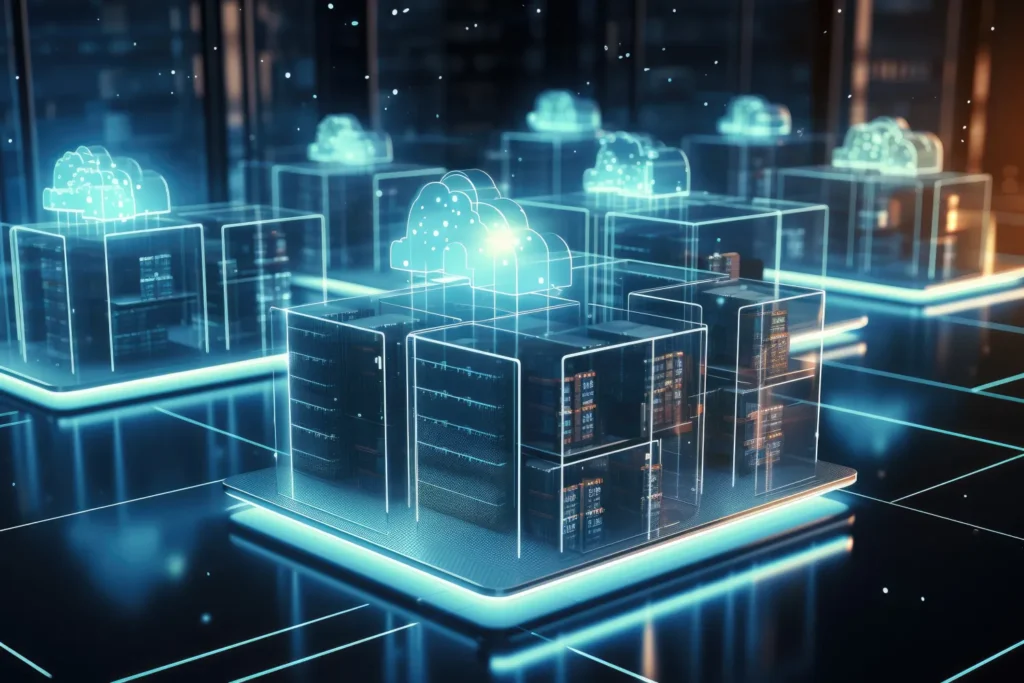While cloud computing centralizes resources and data processing in large remote centers, edge computing offers an innovative and decentralized approach. It consists of processing data close to the source, that is, where it is generated, such as IoT sensors, surveillance cameras or mobile devices. This approach aims to reduce latency, save bandwidth and improve system responsiveness, especially in environments where near-instantaneous response times are required.
With the proliferation of connected devices and smart objects, edge computing has become essential to meet the growing need for rapid data processing. Companies and organizations can thus better meet user performance requirements, while offloading networks and reducing the costs of transferring data to distant cloud centers. This decentralized technology also opens the way to new applications in areas ranging from smart cities to autonomous cars.
How it works and use cases
How does edge computing work?
Unlike cloud computing, which relies on remote data centers to process and store information, edge computing processes data closer to where it is generated. This means that devices located at the edge of the network, such as sensors, cameras, or IoT (Internet of Things) devices, analyze the data locally, without having to transfer it to a centralized data center.
Edge computing relies on « peripheral nodes », servers or devices that can process part of the data autonomously before sending only the essential information or results to data centers for further processing or storage. This approach makes it possible to accelerate real-time decision-making, especially in contexts where every millisecond counts.
Use cases
Edge computing has a variety of applications and is particularly useful in sectors where processing speed and low latency are critical factors. Here are some examples:
* Smart cities: Smart city infrastructures, such as connected public lighting, traffic management systems or environmental sensors, benefit from Edge computing to analyze data in real time and make instant decisions, such as adjusting traffic lights according to traffic density.
* Autonomous cars: Autonomous vehicles require extremely fast data processing to analyze the environment (via sensors, cameras, radars) and react immediately to critical situations. Thanks to Edge computing, these vehicles can process information directly on board, ensuring optimal safety.
* Augmented reality: Augmented and virtual reality applications require near-instantaneous response times to provide a smooth and immersive user experience. Edge computing makes it possible to offer this responsiveness by processing data directly on the device, without latency due to sending the information to a remote center.
* Connected objects (IoT): IoT devices, such as industrial sensors, smartwatches or medical devices, produce large amounts of data in real time. Edge computing allows this data to be processed locally for immediate actions, such as sending alerts, without network overload.
The Benefits and Challenges of Edge Computing
Benefits
Edge computing has several benefits that make it essential for many applications, especially in environments where responsiveness is paramount.
* Reduced latency: One of the main benefits of edge computing is the significant reduction in latency. By processing data as close as possible to its source, this technology allows for near-instantaneous response times, which are crucial in sectors such as transportation (self-driving cars) or online gaming.
* Better bandwidth utilization: Edge computing saves bandwidth by reducing the amount of data that must be transferred to data centers. Only essential information is sent, which significantly reduces network traffic, while optimizing the use of cloud resources.
* Decentralized processing: Edge processing allows for more efficient distribution of workloads. Data can be processed locally and instantly, without going through a centralized infrastructure, which increases the resilience of systems in the event of a centralized data center failure.
Challenges
Despite its advantages, edge computing is not without its challenges. These obstacles must be overcome to ensure widespread and effective adoption of this technology.
* Securing edge processing nodes: One of the biggest challenges of edge computing is securing devices at the edge of the network. Since these devices are more exposed to cyber threats, it is essential to implement robust security measures to prevent attacks and ensure the integrity of data processed at the edge.
* Complexity of data management: Managing data in an edge environment is more complex than with a centralized cloud approach. The decentralization of devices and processing nodes leads to data fragmentation, which can complicate their management, analysis, and storage.
* Interoperability with cloud systems: Edge computing does not replace the cloud, but rather complements it. This means that businesses must ensure that their edge systems are able to work in harmony with their cloud infrastructures. This interoperability can be complex to manage, especially when it comes to synchronizing data processed locally with that stored in remote data centers.
Complementary technologies for digital transformation
Networks, cloud computing and edge computing form an interconnected technology ecosystem that is essential to support the digital transformation of our society. Each technology plays a distinct but complementary role: networks facilitate global communication, the cloud offers flexible and scalable computing power, and edge computing ensures optimal responsiveness for services requiring localized and rapid processing.
Together, these three technologies enable businesses and end users to benefit from advanced digital solutions, offering increased performance, better resource management and greater flexibility. Edge computing, in particular, stands out for its ability to meet the requirements of critical applications in terms of latency and real-time processing, while reducing the burden on centralized infrastructures. This complementarity between the Cloud and the Edge opens the way to new innovations in sectors as varied as industry, health, transport and telecommunications, thus helping to shape the future of the digital economy.

